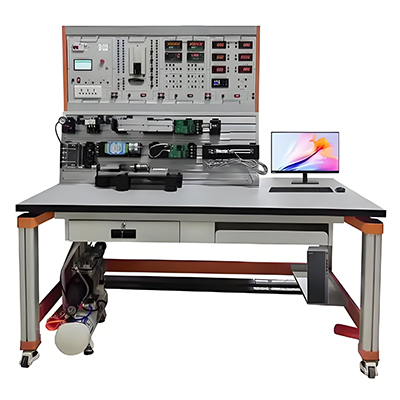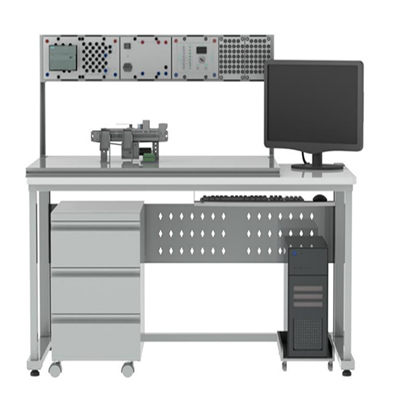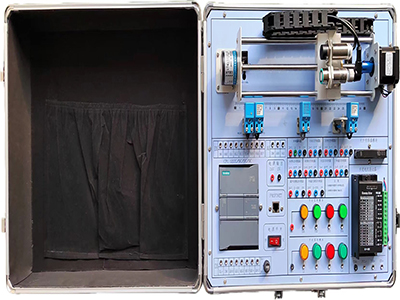This comprehensive training platform for industrial sensor application and detection uses PLC as the core main control unit in conjunction with industrial sensors for teaching. Students can install and debug sensor circuits in a similar industrial debugging site, which can enable students to vividly and deeply understand the use and detection of various sensors in industrial sites. It can be used for innovative teaching, can be used to improve sensor teaching, and can train students' application selection, fault analysis and diagnosis capabilities of industrial sensors.
GLCG-RB industrial sensor application and detection comprehensive training platform
Ⅰ、Equipment Overview
This industrial sensor application and detection comprehensive training platform uses PLC as the core of the main control unit and industrial sensors for teaching. Students can install and debug sensor circuits at similar industrial debugging sites, which can enable students to vividly and deeply understand the use and detection of various sensors in industrial sites. It can be used for innovative teaching, can be used to improve sensor teaching, and can train students to select industrial sensors for application, fault analysis and diagnosis.
This experimental bench uses industrial aluminum profiles to build a training bench. The function adopts a modeling design, mainly based on a variety of small application scenarios, and each model can be flexibly installed on the bench. It is composed of modules such as integrated digital sensors, analog sensors, intelligent sensors, electrical control units, and equipment basic benches. The sensors in each module use industrial-grade sensors, which can form a small system independently. The connection between the sensor and the PLC, the wiring port can be plugged out to the panel with a quick connector for easy operation.
Ⅱ、Device Features
1. Strong comprehensiveness It integrates multiple experimental projects such as PLC basic teaching, understanding and use of industrial sensors.
2. Strong adaptability The depth and breadth of the experiment can be flexibly adjusted according to needs, and popularization and improvement can be organically combined according to the progress of teaching.
3. Strong consistency The experimental devices are reasonably selected and fully equipped, so that the results of multiple groups of experiments have good uniformity, which is convenient for teachers to organize and guide experimental teaching.
4. Strong intuitiveness This device adopts a structural form that combines the whole and the module. The tasks of each experimental module are clear, and the operation and maintenance are simple.
5. Strong scalability This device can complete the design of comprehensive and innovative experimental projects according to the actual needs of real life scenes or industrial scenes.
Ⅲ、Equipment composition
1. Training workbench
This industrial sensor application and detection comprehensive training platform is mainly built with industrial aluminum profiles, and the table is distributed with regular T-slots, providing a placement platform for adjustable installation of functional components. Casters are installed at the bottom of the workbench to facilitate the movement and fixation of the workstation; the overall dimensions of a single workbench are approximately 1600mm long × 950mm wide × 850mm high. Each set of equipment is equipped with two computers that meet the requirements.
2. Electrical control unit
① Data acquisition card:
It can collect digital analog signal input and output points. The supporting software has the following functions: real-time acquisition of experimental data, dynamic or static processing and analysis of data.
② Programmable controller:
Configured with Siemens 1200 series PLC, CPU1214C DC/DC/DC: power supply: DC 20.4-28.8V, programmable data storage area: program memory 150KB; equipped with CM1241 serial communication module.
(1) Communication: ProfiNET communication.
(2) Digital input, output, analog input, high-speed counter: 14DI DC input 24V; 10DQ transistor output 24V DC; 2AI analog input 0-10V DC; supports up to 6 high-speed counters.
(3) Number of ports: 1 Ethernet port.
(4) Protocols: TCP/IP transmission protocol, open user security communication, S7 communication, Web server, OPC UA: server DA and other communication methods.
③ Human-machine interface:
Configured with MCGS resistive touch screen, adaptable to industrial environment, and supports glove operation.
(1) Size: 7-inch TFT LCD screen;
(2) Resolution: 800*480;
(3) Serial interface: RS232*1; RS485*1; support Modbus RTU protocol;
(4) Ethernet port: 10/100M adaptive, support Modbus TCP protocol;
④ Video and image processing software:
The data collected by the visual sensor and image sensor can be processed and analyzed through software. It can perform various operations such as denoising and filtering, color correction, geometric correction, edge detection, texture analysis, etc. on the original image.
⑤Industrial sensors:
Includes a variety of industrial sensors, such as illumination sensors, temperature and humidity sensors, pyroelectric infrared sensors, combustible gas sensors, smoke sensors, photoelectric sensors, Hall sensors, encoders, RFID read/write modules, color mark sensors, visual sensors, flow sensors, water level sensors, fingerprint sensors, metal proximity sensors and other detection equipment.
Control objects:
Equipped with a variety of actuator objects, such as red, green, yellow and other color lights, stepper motors (including controllers), temperature source modules, small water pumps, etc., as the core driving components of the control system, converting control instructions into actual physical actions for dynamic adjustment and adaptive control of the control system.
Ⅳ、Reference experiments
1. Illuminance experiment
2. Temperature experiment
3. Humidity experiment
4. Infrared alarm experiment
5. Combustible gas alarm experiment
6. Smoke alarm experiment
7. Characteristics and applications of photoelectric sensors
8. Characteristics and applications of magnetic induction sensors
9. Characteristics and applications of inductive sensors
10. Application of encoders
11. Application of RFID
12. Characteristics and applications of color mark sensors (various color recognition)
13. QR code system
14. Video and image recognition (color and shape, etc.) experiment
15. Flow detection experiment
16. Water level monitoring experiment
17. Face recognition experiment
18. Fingerprint recognition experiment
19. Photoelectric switch experiment
20. Metal detection experiment
21. Speed measurement experiment

Synchronous PC version:
GLCG-RB industrial sensor application and detection comprehensive training platform https://www.biisun.com/home/category/detail/id/131.html


 Italian
Italian German
German Russian
Russian Turkish
Turkish Portuguese
Portuguese Spanish
Spanish French
French




